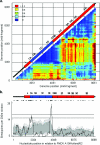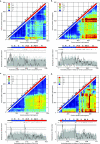Recombination patterns in aphthoviruses mirror those found in other picornaviruses
- PMID: 16971423
- PMCID: PMC1642601
- DOI: 10.1128/JVI.01100-06
Recombination patterns in aphthoviruses mirror those found in other picornaviruses
Abstract
Foot-and-mouth disease virus (FMDV) is thought to evolve largely through genetic drift driven by the inherently error-prone nature of its RNA polymerase. There is, however, increasing evidence that recombination is an important mechanism in the evolution of these and other related picornoviruses. Here, we use an extensive set of recombination detection methods to identify 86 unique potential recombination events among 125 publicly available FMDV complete genome sequences. The large number of events detected between members of different serotypes suggests that horizontal flow of sequences among the serotypes is relatively common and does not incur severe fitness costs. Interestingly, the distribution of recombination breakpoints was found to be largely nonrandom. Whereas there are clear breakpoint cold spots within the structural genes, two statistically significant hot spots precisely separate these from the nonstructural genes. Very similar breakpoint distributions were found for other picornovirus species in the genera Enterovirus and Teschovirus. Our results suggest that genome regions encoding the structural proteins of both FMDV and other picornaviruses are functionally interchangeable modules, supporting recent proposals that the structural and nonstructural coding regions of the picornaviruses are evolving largely independently of one another.
Figures


References
-
- Belsham, G. J. 2005. Translation and replication of FMDV RNA. Curr. Top. Microbiol. Immunol. 288:43-70. - PubMed
-
- Domingo, E. 2000. Viruses at the edge of adaptation. Virology 270:251-253. - PubMed
-
- Fauquet, C. M., M. Mayo, J. Maniloff, U. Desselberger, and L. A. Ball. 2005. Virus taxonomy. Eighth report of the International Committee on Taxonomy of Viruses. Academic Press, London, United Kingdom.
Publication types
MeSH terms
LinkOut - more resources
Full Text Sources

